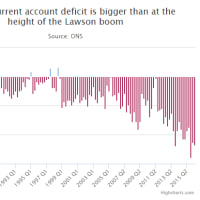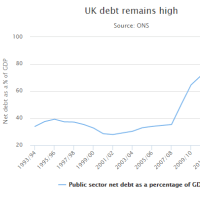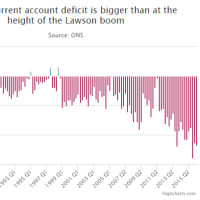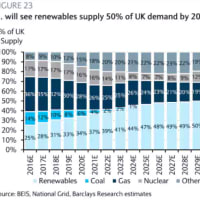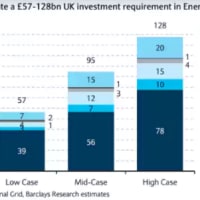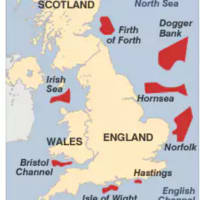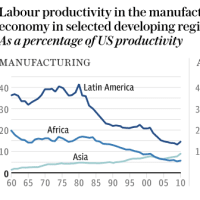Global crisis moves East as China suffers rapid downturn
(中国が急激な景気後退に悩まされる中、世界的な危機は東へ)
By Ambrose Evans-Pritchard
Telegraph: 9:09PM BST 03 Sep 2012


(中国が急激な景気後退に悩まされる中、世界的な危機は東へ)
By Ambrose Evans-Pritchard
Telegraph: 9:09PM BST 03 Sep 2012
China’s industrial output is contracting at the fastest pace since the depths of the global financial crisis, with knock-on effects spreading across the Far East.
中国の工業生産が世界的な金融危機の底以来最速のスピードで縮小中で、その連鎖反応は極東全域で広がりつつあります。
“It just keeps getting worse,” said Alistair Thornton and Xianfang Ren from IHS Global Insight. “The government has underestimated the pace of the slowdown and is behind the curve.”
「とにもかくにも悪化する一方だ」とIHSグローバル・インサイトのアリステア・ソーントン氏とシャンファン・レン氏は言います。
「政府は減速ペースを甘く見ていた。後手後手に回っている」
The HSBC/Markit manufacturing index for China fell to 47.6 in August, the lowest since the onset of Great Recession in late 2008. Inventories are rising. The index for new export orders fell to the lowest since March 2009. “Beijing must step up policy easing to stabilise growth,” said Hongbin Qu from HSBC.
8月、HSBC/Markitの中国製造業指数は47.6下落しましたが、これは2008年下旬の大不況勃発以降最低水準です。
在庫は増加中です。
同輸出受注指数は2009年3月以降最低地まで下落しました。
「中国政府は成長を安定させるために政策緩和を強化しなければならない」とHSBCのホンビン・クー氏は言いました。
China’s official PMI manufacturing index – weighted to big companies – also fell through the contraction line of 50, though services are holding up better.
中国当局の製造業購買担当者指数(大企業に重点を置いています)も拡大と縮小の分かれ目になる50を切りましたが、サービス業は持ちこたえています。
Evidence of a hard landing over the summer is becoming clearer. Rail volumes fell 8.2pc in July from a year before. The Japanese group Komatsu said its exports of hydraulic excavators to China – a proxy gauge for Chinese construction – fell 48pc in August from a year before.
夏のハードランディングの証拠は益々明らかになりつつあります。
7月の鉄道輸送量は前年を8.2%下回りました。
コマツ・グループによると、同社の油圧掘削機の対中輸出(中国建設業の代理指標)は、8月に前年比-48%に落ち込んだとのことです。
The twin effect of China’s downturn and Europe’s double-dip recession has turned into a full-blown shock for much of Asia. Hong Kong and Singapore both contracted in the second quarter and are probably in technical recession.
中国の景気後退と欧州の二番底という二重苦は、アジアの株式市場の大多数に大きなショックとなりました。
香港とシンガポールの市場は両方とも第2四半期は縮小しており、恐らくテクニカル的には不況にあると思われます。
South Korea’s exports fell 6.2pc in August, with car sales down 18.2pc. India’s exports fell 14.8pc in July, an extra blow as it grapples with its own post-boom hangover. “The coming days ahead are tough,” said Indian commerce secretary S R Rao.
韓国の8月の輸出は6.2%減少し、自動車販売は18.2%減少しました。
インドの7月の輸出は14.8%減少していますが、これは自国の景気の波による不調に苦しんでいるところへの追い討ちとなりました。
「これからが厳しい」とインドのラオ商務次官は言いました。
Stephen Jen from SLJ Macro Patrners said we are starting to see Phase III of the global crisis as “the eye of the storm moves East”, with China and emerging markets succumbing at last to the effects of debt leverage.
SLJマクロパートナーズのスティーヴン・ジェン氏によれば、我々は、「台風の目が東へ移動」し、中国と新興市場が遂に債務レバレッジの影響に屈する中で、世界的な危機の第3フェーズを目にし始めたのだそうです。
Mr Jen said markets have already discounted any likely trouble in Europe and America, but have yet to “price” the mounting risks in Asia correctly. “There seems to be a big gap between the prevalent view on China, and what is likely to happen: the sanguine consensus view that China can do no wrong will likely be proven to be incorrect,” he said.
ジェン氏いわく、マーケットは既にヨーロッパと米国で想定されるトラブルを無視しているが、まだアジアで高まりつつあるリスクを正確に「折り込んで」いないそうです。
「中国に関する一般的な見解と起こる可能性の高いことの間に、大きなギャップがあるようだ。中国は何も間違ったことをしていない、という楽観的な大多数の意見は間違いだと証明されそうだ」
Jim O’Neill from Goldman Sachs said the Chinese government will “surely step in” if the calibrated soft landing slips control. The central bank has kept monetary policy tight to keep a lid on property prices and rein in rampant loan growth, up by almost 100pc of GDP in five years.
調整されたソフト・ランディングが制御出来なくなれば、中国政府は「確実に介入する」、とゴールドマン・サックスのジム・オニール氏は言います。
中国人民銀行は、不動産価格を抑制し、5年間でGDP比100%近く増大した猛烈な融資を制御するために、金融引き締めを維持しています。
The authorities cut the required reserve ratio for banks in May to 20pc – still very high by global standards – but have refused to ease further despite ever louder pleas for action from the markets. Governor Xiaochuan Zhou opened the door to monetary loosening last week, saying a change in the reserve ratio was “still possible”.
中国政府は5月、銀行の支払い準備率を20%まで引き下げました(それでも世界的な基準から見れば非常に高い水準ですが)。
しかし、対策を嘆願するマーケットからの声がこれまで以上に高まっているにも拘らず、追加緩和を行うことは拒絶しています。
周小川総裁は先週、準備率の変更は「未だ可能性はある」と発言して、金融緩和への扉を開きました。
China’s regions have unveiled vast infrastructure and stimulus projects over recent weeks with the blessing of the Politburo, but it is unclear how these can be financed. Beijing-based media group Caixin reports that Beijing, Shanghai and other cities already face a “budget crunch” as land-sale receipts fall sharply.
中国の地方は数週間前から、政務局の支持を得て、大規模なインフラ計画と景気刺激策を発表していますが、どのような資金調達が可能なのかは不明です。
北京を本拠地とするメディア・グループ、財新紙が報じたところによると、上海など幾つかの都市は既に地価暴落により「予算不足」に見舞われているとのことです。
Local governments have $1.7 trillion (£1.07 trillion) in debts through 6,000 arms-length vehicles, described by Cheng Siwei from Beijing’s International Finance Forum as China’s “sub-prime” crisis.
地方自治体の関連会社6,000社を通じた借金は1.7兆ドルに上り、北京の国際金融フォーラムのチェン・シウェイ氏はこれを中国版「サブプライム」危機と呼んでいます。
The state-run banks can clearly crank up lending if told to do so, but Fitch Ratings says the law of diminishing returns has already set in, with each extra yuan of debt generating less than half a yuan in extra growth.
政府系銀行が命令により貸し出しを増強することは明らかに可能ですが、フィッチによれば、収穫逓減の法則は既に始まっており、債務一元当たりが生み出す利益は0.5%をも下回っている状態だそうです。
Overdue loans at major banks jumped 27pc in the first half of the year. The steel industry alone has $400bn of debts.
主要銀行の不良債権率は今年上半期の間に27%も急増しました。
鉄鋼業だけでも4,000億ドルの債務があります。
China will have to steer a delicate course, offering just enough stimulus to keep the show on the road without reverting to the dangerous excesses of the last five years.
中国は、過去5年間の危険な過剰に立ち戻ることなく道を示し続けられるだけの景気刺激策だけ提示するという、慎重な立ち回りをしなければならなくなるでしょう。











